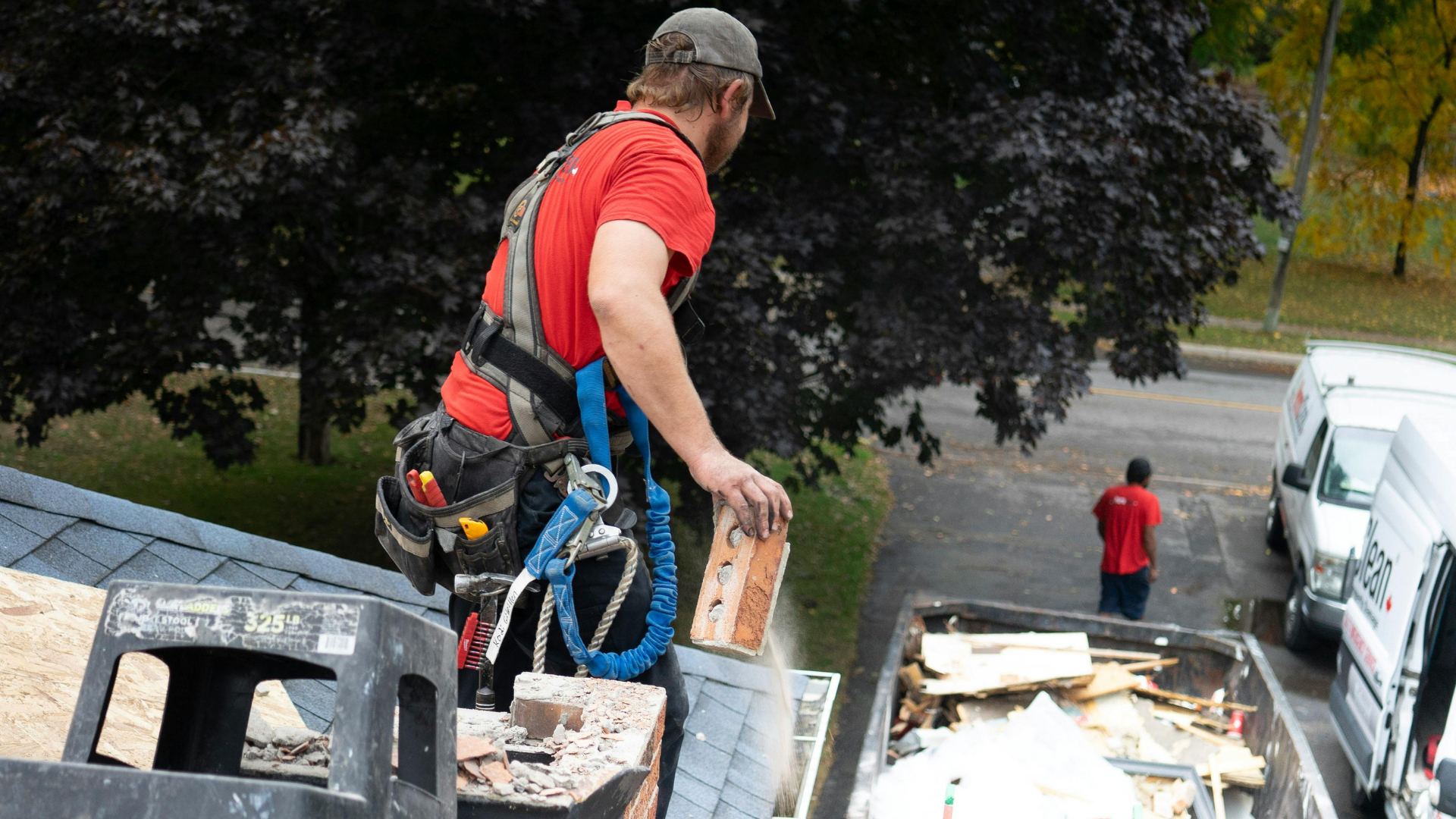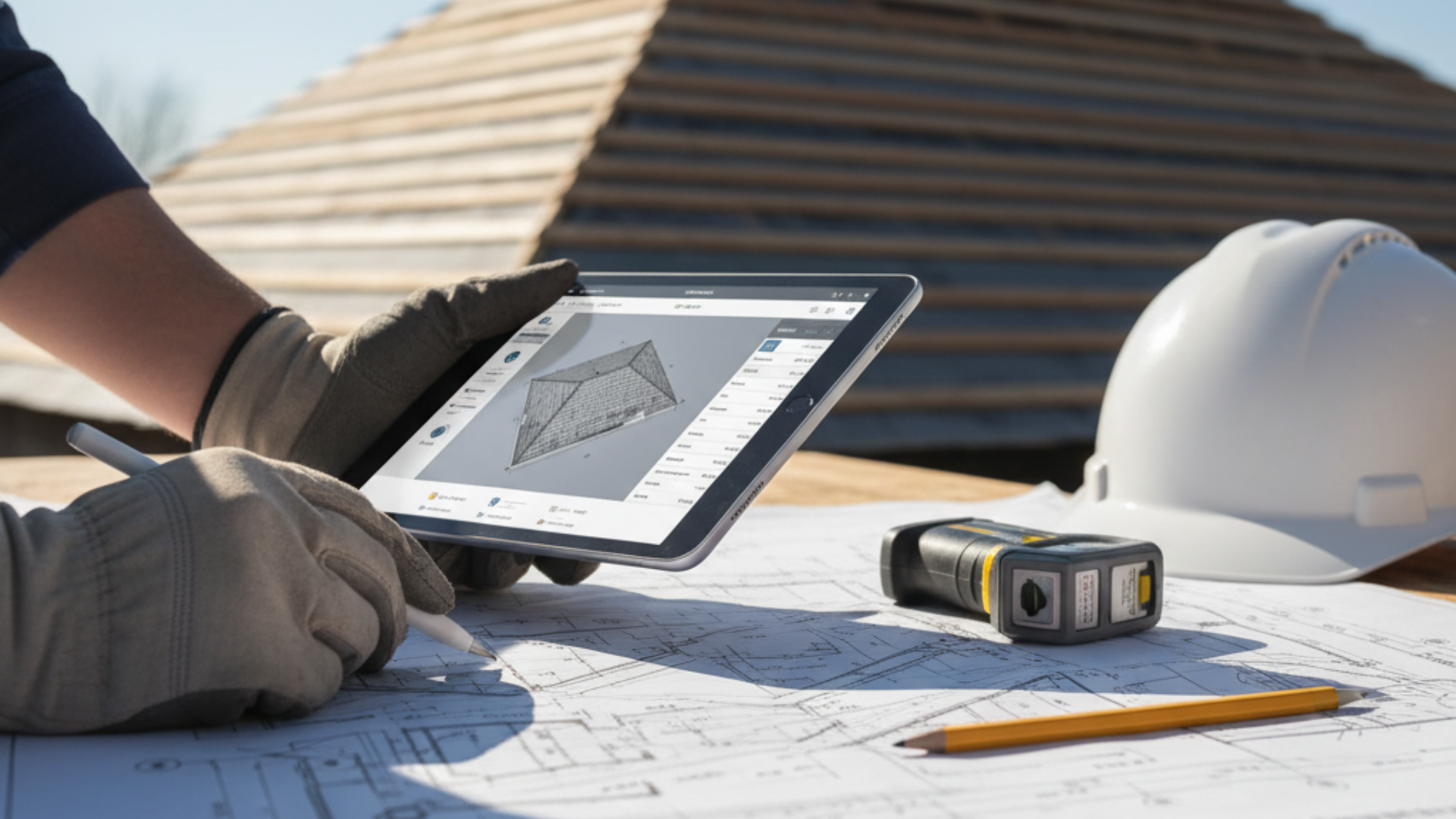July 8, 2025
Audio overview: Listen & Learn
The roofing industry is facing heightened competition than ever before.
While some companies are still buried in paperwork and phone tags, others are closing deals, dispatching crews, and collecting payments all from one streamlined system.
And that's where staying ahead becomes more manageable with automation.
In this step-by-step guide, we’ll show you how to automate your roofing business and build a workflow that supports growth, happy customers, and fewer headaches.
A Step-by-Step Guide to Automating Your Roofing Business
Whether you’re handling just a few roofing projects or managing multiple locations, staying competitive is all about operating smarter and better.
Automation tools help roofing contractors streamline repetitive tasks, freeing up time to focus on growth. Let’s explore what that looks like in practice.
Key Takeaways
- Manual processes can significantly consume time and impact profits. Finding ways to streamline these tasks could make a big positive difference!
- Roofing software can automate tasks such as generating quotes, sending follow-ups, scheduling appointments, and more.
- A solid roofing CRM keeps your customer details, photos, documents, and job data in one place.
- Taking small automation steps now can lead to even bigger, scalable growth in the future.
Why Roofing Businesses Struggle to Scale Without Automation
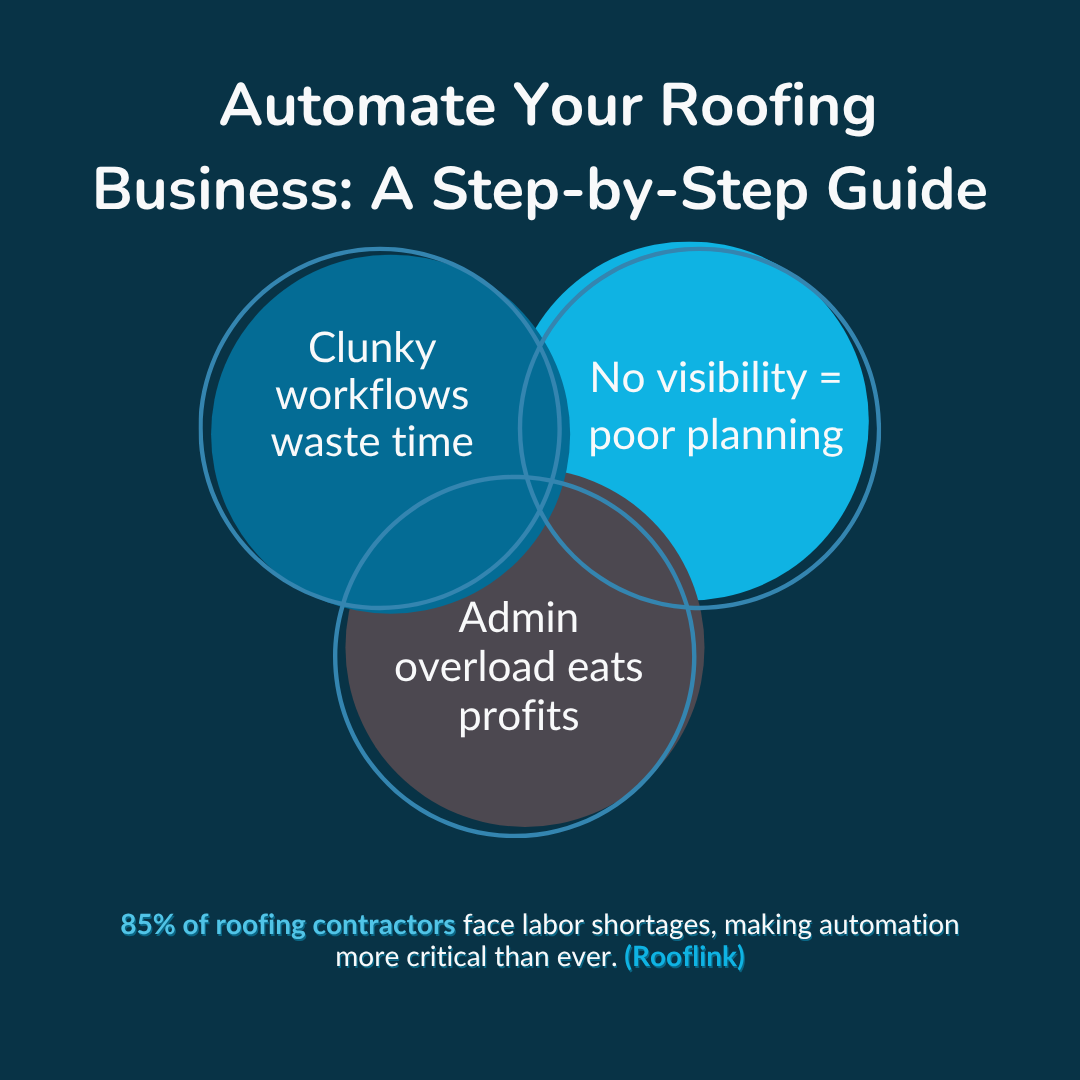
Scaling a roofing business is about taking on and managing more jobs without everything falling apart behind the scenes. And that’s precisely where many roofing contractors hit a wall.
Over 85% of roofing contractors report skilled labor shortages, which only amplifies the pressure on project managers to do more with less. (Rooflink)
Let’s break down the three biggest blockers:
1. Slow Workflows Waste Time
When every lead, quote, job, and update depends on phone calls, spreadsheets, or sticky notes, it creates unnecessary issues.
Your roofing team spends more time managing the process than doing the actual work. The result? Delays, frustrated customers, and lost opportunities.
2. Lack of Visibility = Missed Opportunities
If you can’t see where your projects, crews, or payments stand in real-time, you're running your business in the dark.
That lack of visibility leads to overbooking, underscheduling, missed follow-ups, and poor communication, all of which hurt your ability to scale.
3. Administrative Overload Hurts Profitability
Manual admin work, data entry, customer updates, photo uploads, and payment tracking can pile up fast.
And the more you grow, the more this load multiplies. This eats into your profit margins and takes time away from high-value tasks, such as closing deals or planning new roofing projects.
Did you know that approximately one-third of sales tasks can be automated? This saves time typically spent on manual administrative work and allows teams to concentrate on revenue-generating activities. (Source)
What You Can Automate in a Roofing Business (Step-by-Step)
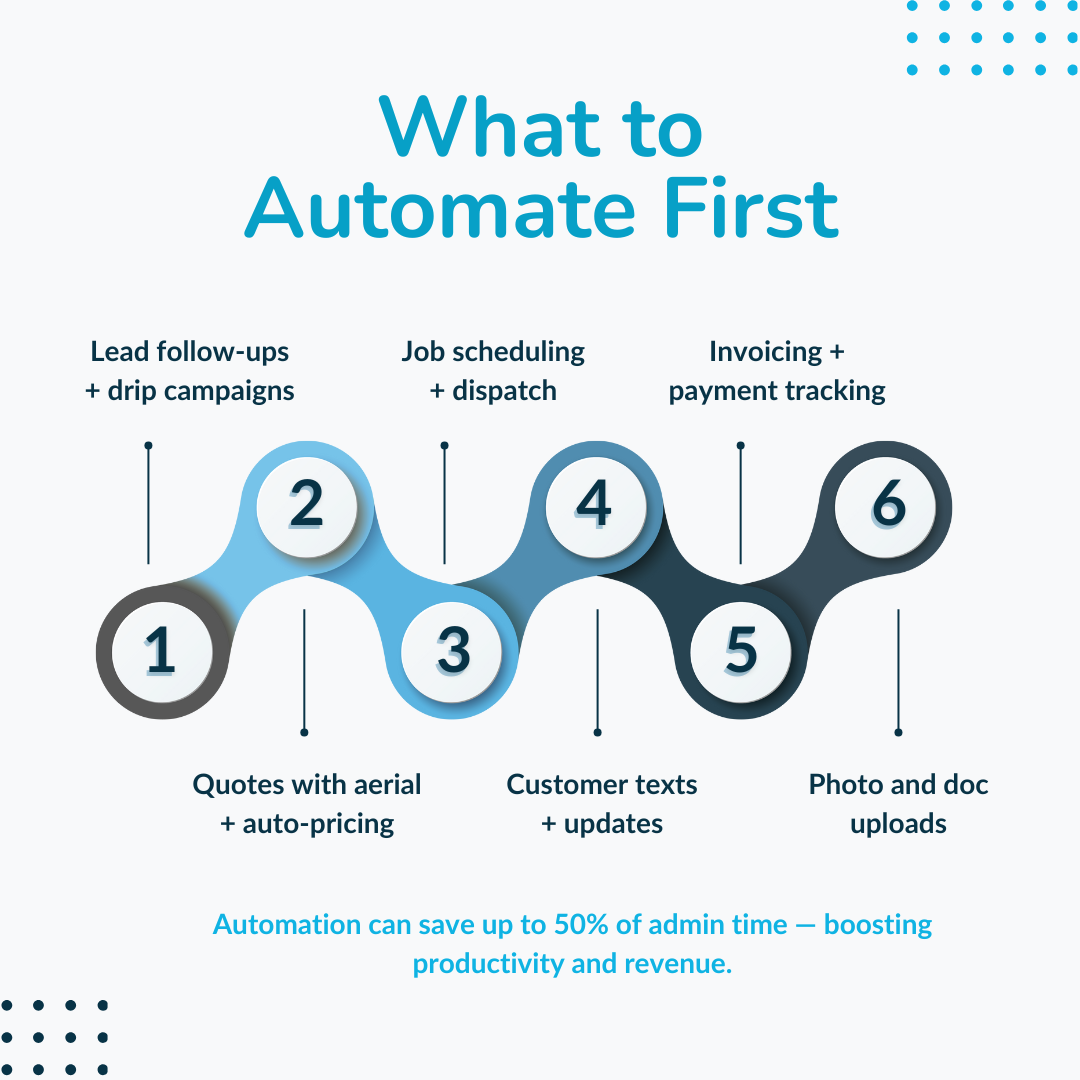
You don’t need to overhaul everything at once. Start with the tasks that drain the most time or create the most friction, then build from there.
Here’s what many roofing businesses begin automating first:
1. Lead Management and Follow-ups
Manual follow-ups lead to missed sales. With the right roofing CRM software, you can automate follow-ups, nurture new leads, and stay top of mind without lifting a finger.
Some platforms even let you set up drip campaigns, automated messaging, and reminders for your sales team.
Companies that use a CRM report a 29% boost in sales and 34% higher productivity, all from automating lead tracking, customer interactions, and follow-ups
(Sunbase).
2. Quote Creation and Estimation
Creating estimates from scratch eats up hours. With automated proposal tools and advanced measurement tools (like aerial measurements), you can generate professional, accurate quotes in minutes, complete with photos, pricing, and scope of work.
This speeds up closing deals and keeps your sales process consistent.
Learn more: Manual versus Automated Roofing Measurements – Which is more effective?
3. Job Scheduling and Crew Dispatch
No more endless back-and-forth calls. Automating your job scheduling allows you to assign crews, update calendars, and manage multiple job sites in real-time.
Many roofing CRM platforms include drag-and-drop scheduling and dispatch tools that notify your roofing team instantly.
4. Customer Communication and Updates
Utilize automated systems to keep customers informed at every step, including confirmation texts, status updates, photo progress updates, review requests, and more.
This enhances customer satisfaction and builds trust without constant manual effort.
5. Invoicing and Payments
Streamline your billing processes with integrated invoicing and payment processing tools.
You can set up automatic invoice triggers, send reminders, and even offer integrated financing, all from one dashboard. This improves cash flow and removes friction from your customer experience.
6. Document and Photo Management
Job data, permits, before-and-after photos, and customer signatures can be automated for the collection, storage, and sharing of these documents.
Some roofing CRM platforms offer mobile uploads from the job site, allowing your crew to send updates in real-time.
Each of these can be handled by an all-in-one platform or through a mix of specialized automation tools. We’ll break down your options next.
Tools That Make Roofing Automation Simple
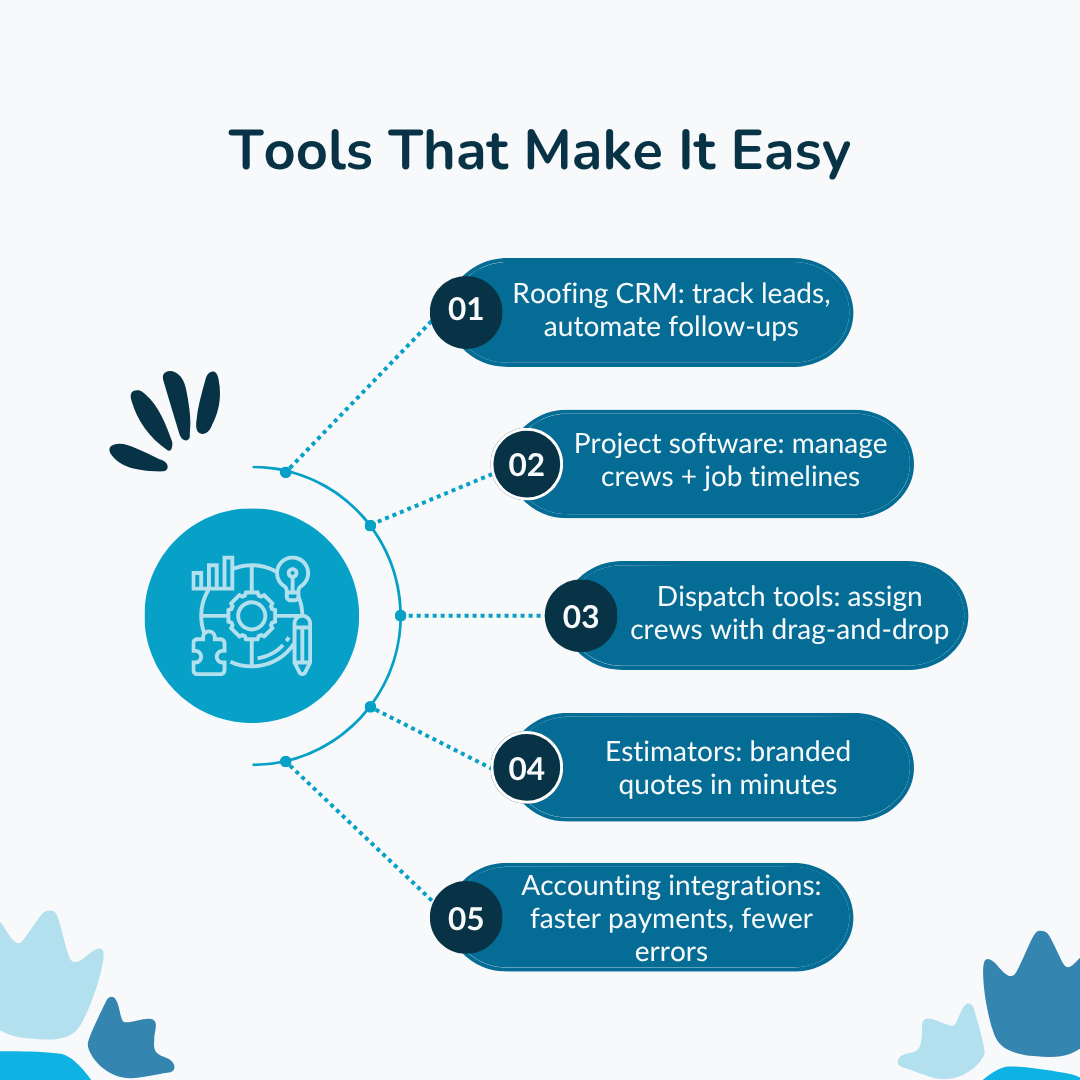
You don’t need dozens of apps to automate your roofing business. The best roofing companies utilize just a few smart tools that handle most of the heavy lifting, requiring no technical degree.
Here’s what to look for:
1. Roofing CRM Platforms
A roofing CRM is your central command hub. It stores all your customer details, tracks every job, automates follow-ups, and keeps your sales process moving. The best
roofing CRM platforms also let your sales reps send estimates, book jobs, and view job site updates from anywhere.
Rooferbase is one such all-in-one platform, built specifically for roofing contractors, that helps you automate follow-ups, manage leads, and streamline operations from lead to payment.
Here's a must-read: CRM for Roofers: Designed for Speed, Sales, and Simplicity
2. Project Management Software
From scheduling crews to managing job site tasks, project management tools help you stay on top of everything without micromanaging.
Look for software tools that integrate directly with your roofing CRM, allowing for easy drag-and-drop timelines, file sharing, and team updates.
3. Scheduling and Dispatch Tools
Automated scheduling tools reduce mix-ups and save your admin team from endless rescheduling.
Many roofing CRM platforms come with built-in dispatch features, enabling you to assign crews, update schedules, and send job alerts, all without requiring duplicate data entry.
4. Estimation and Proposal Generators
Speed up your sales cycle with estimation tools that enable you to create accurate, branded quotes in minutes.
The best roofing software includes templates, roof measurement tools, and pre-filled pricing based on materials or service type.
5. Integration with Accounting and Payment Apps
Whether you’re using QuickBooks, Stripe, or another platform, the right roofing CRM will integrate seamlessly with it. These integrations reduce manual work, streamline payment processing, and maintain a steady cash flow.
With the right automation tools in place, your roofing business can close more sales, handle more jobs, and improve the customer experience without adding more stress to your day.
Implementation: How to Start Automating Your Roofing Business
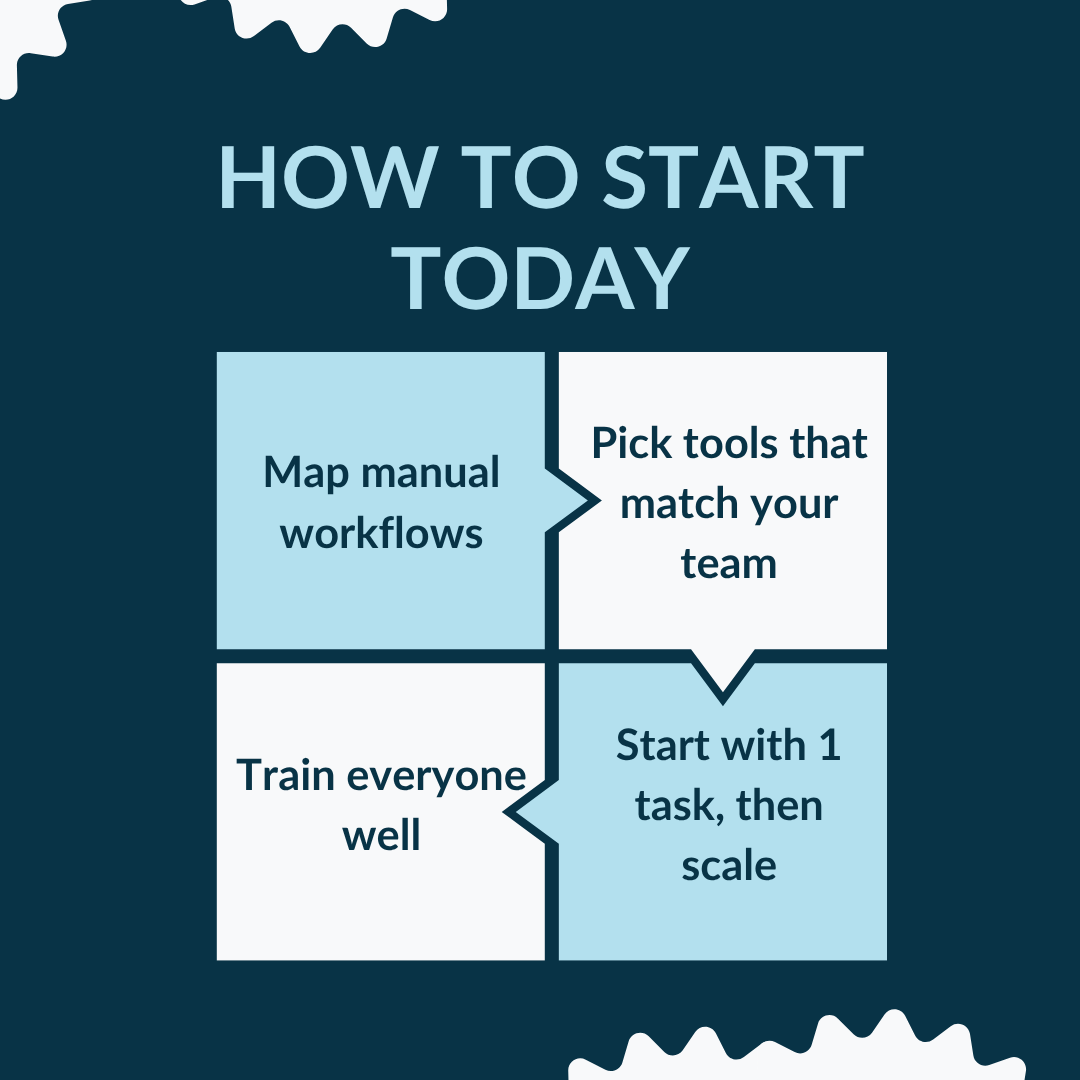
Automation doesn’t have to be all-or-nothing. Here’s how to do it right:
Step 1: Map Your Manual Workflows
Before automating any process, write down how things are currently done: lead intake, quoting, scheduling, customer communication, invoicing, etc.
Identify repetitive tasks, double data entry, or steps that slow you down. This gives you clarity on what to streamline first.
Step 2: Choose Software That Matches Your Business Size
You don’t need the most expensive roofing software, just one that fits your current needs and offers room to grow.
Look for an all-in-one platform like Rooferbase that simplifies lead management, job tracking, and payment processing without overwhelming your team.
Step 3: Train Your Team
Your automation tools are only as good as your crew’s ability to use them. Take time to train your sales team, project managers, and field crews.
Show them how automation makes their work easier, reduces the need for phone calls, organizes job data more efficiently, and facilitates smoother customer interactions.
Step 4: Start Small, Then Scale
Select one high-impact area to automate first, such as estimates or follow-ups, and implement it fully. Once your team is comfortable, expand into other areas, such as scheduling, photo uploads, or automated messaging. This phased approach avoids overwhelm and builds momentum.
With these four steps, many roofing businesses are saving time, closing more jobs, and improving customer relationships along the way.
What Results to Expect from Roofing Process Automation
Once your roofing business starts using automated systems, the results are evident quickly, both in your day-to-day operations and your bottom line.
Here’s what you can expect:
1. Time Savings Across the Board
From quote creation to customer updates, automation eliminates repetitive tasks that slow down your team. That means more time for roofing jobs, less burnout, and fewer admin headaches.
Whether it’s auto-generated estimates or automated follow-ups, your crew and office staff get hours back every week.
2. Higher Customer Satisfaction
Automation helps you enhance customer satisfaction by keeping homeowners informed without requiring you to send every message manually. From review requests to appointment confirmations and photo updates, customers feel cared for and informed.
The result? Happy customers, more referrals, and better online reviews.
3. Scalable Growth
Many roofing businesses struggle when growth brings disorganization. But with the right roofing CRM and automation tools, you can take on more jobs, manage more
leads, and process more payments without hiring a huge admin team or losing control of quality.
With the global roofing market valued at $213.8 billion in 2023 and projected to reach $280.3 billion by 2029, a steady 4.6% CAGR, there has never been a better time to scale smart and automate your workflows. (Researchandmarkets)
Whether you’re a small team or managing roofing projects across multiple locations, automating key workflows is the most reliable way to increase cash flow, boost efficiency, and deliver the best possible roofing service.
Read more: The Future of Roofing Software: Upcoming Trends and Innovations
Why Choose Rooferbase?
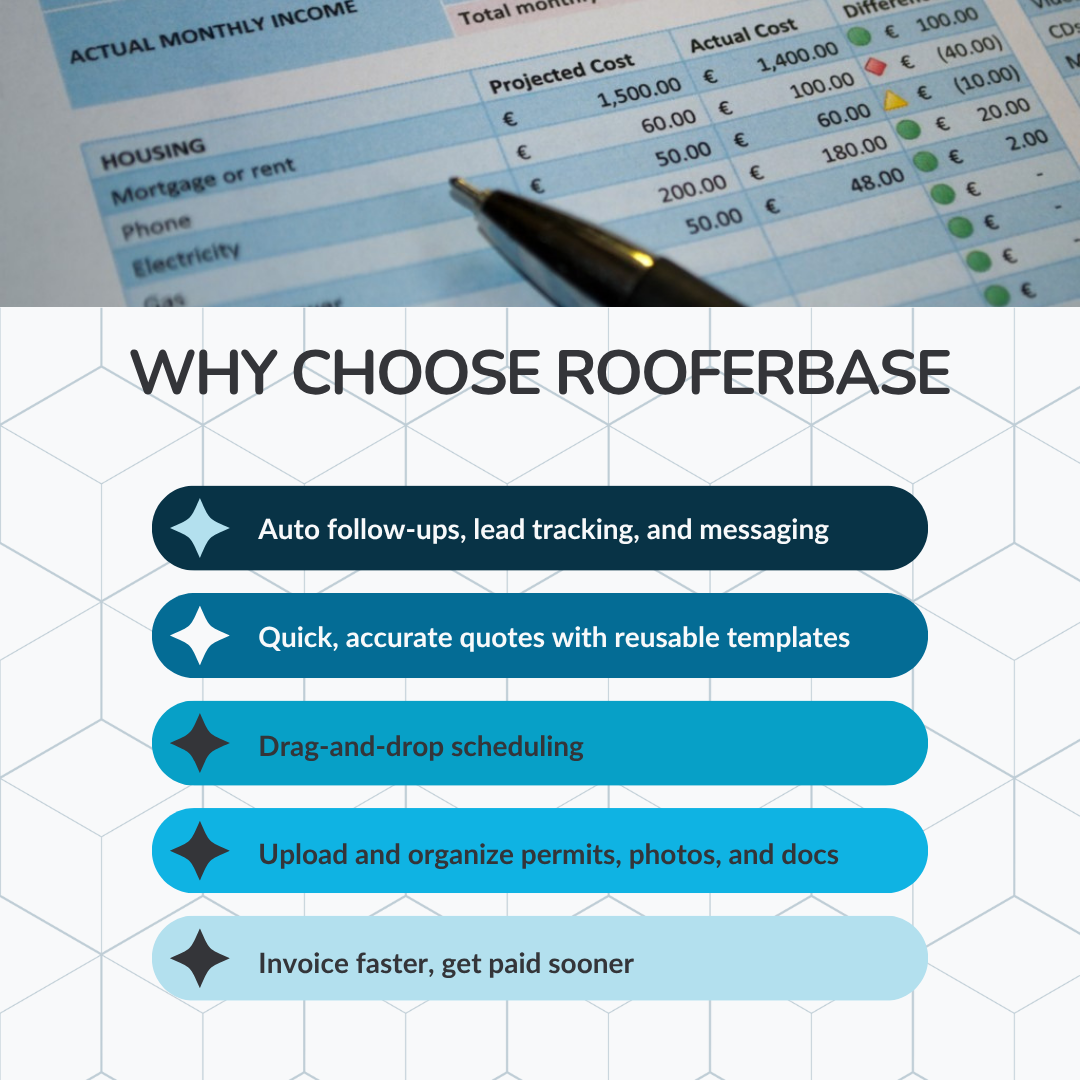
Rooferbase is an all-in-one roofing CRM designed to help contractors automate their business and work smarter.
- Automate lead tracking, follow-ups, and customer communication to stay top of mind and close more sales.
- Create fast, accurate estimates using roof measurement tools and reusable templates.
- Schedule crews and manage job timelines with a drag-and-drop calendar that updates in real-time.
- Store and share job photos, permits, and documents in one organized place, accessible from anywhere.
- Streamline invoicing and payments to boost cash flow and reduce admin work.
In a nutshell, Rooferbase makes your everyday life easy!
Summary
Automating your roofing business doesn’t mean replacing your team. It means empowering them to do more in less time.
From lead management and quoting to scheduling, updates, and invoicing, the right tools help you streamline repetitive tasks, improve customer relationships, and grow more efficiently.
Whether you're managing a few roofing projects or scaling across multiple locations, automation is the smartest way to boost efficiency and stay competitive.
Ready to Automate Your Roofing Business?
Imagine closing more deals, completing jobs faster, and never losing track of a lead again, all without hiring more staff or working longer hours. That’s what Rooferbase helps roofing contractors do every day.
Don’t let slow systems hold you back. Book a demo today and see how automation can elevate your roofing business.
FAQs
Q1: How profitable is the roofing business?
Very! Especially when you automate, with lower administrative costs and faster workflows, many roofing businesses can increase their margins and grow more quickly.
Q2: Is it possible for roofers to earn additional profits annually?
Absolutely. With the right mix of skills, local demand, and efficient systems, many experienced roofers or small business owners can cross six figures annually.
Q3: How much money do I need to start a roofing business?
Starting costs can vary, but expect to invest in basic tools, safety gear, insurance, and licensing. Starting lean is possible, especially with digital tools that reduce overhead.





